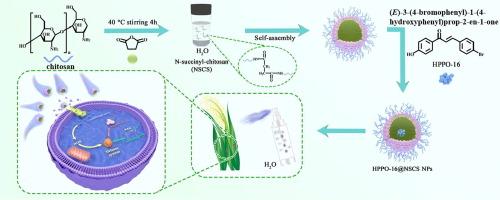当前位置:
X-MOL 学术
›
J. Adv. Res.
›
论文详情
Our official English website, www.x-mol.net, welcomes your
feedback! (Note: you will need to create a separate account there.)
N-succinyl-chitosan as ecofriendly pesticide carriers: Nano encapsulation and synergistic antifungal effect on 4-hydroxyphenyl-2-propenyl-1-one derivatives based on chalcone structure
Journal of Advanced Research ( IF 11.4 ) Pub Date : 2024-05-31 , DOI: 10.1016/j.jare.2024.05.029 Zhi Xia 1 , Qing Zhou 2 , Yu Zhang 3 , Tao Zhang 2 , Wei Xue 2
中文翻译:

N-琥珀酰壳聚糖作为环保农药载体:基于查耳酮结构的 4-羟基苯基-2-丙烯基-1-酮衍生物的纳米包封和协同抗真菌作用
传统农药水溶性差、毒性高、生物利用度低。因此,开发高效、环保的新型化学农药产品和配方,对农药行业的可持续健康发展具有重要意义。
本研究旨在合成一系列基于查耳酮结构 (HPPO) 的衍生物,然后利用 N-琥珀酰壳聚糖 (NSCS) 的两亲性和自组装特性制备HPPO@NSCS纳米颗粒 (HPPO@NSCS NPs),以实现 HPPO 的绿色应用,并探讨 HPPO@NSCS NPs 的抗真菌活性和机制。
以壳聚糖为载体,通过结构修饰合成 NSCS。基于其两亲性和自组装特性,通过与活性小分子 HPPO-16 结合,合理制备了 HPPO-16@NSCS NPs。采用傅里叶变换红外光谱 (FTIR)、透射电子显微镜 (TEM)、动态光散射 (DLS)、荧光光谱 (FS) 和高效液相色谱 (HPLC) 表征 NSCS 和 HPPO-16@NSCS NPs 的理化性质。在体内和体外测试了纳米农药对立枯丝核菌 (R. solani) 的抑制活性。通过观察病原体形态、荧光染色和酶活性测定来探讨抗真菌作用的机制。
成功合成了 28 个基于查尔酮结构 (HPPO-1-28) 的小分子 (HPPO-1-28) 、 NSCS 和 HPPO-16@NSCS。HPPO-16@NSCS 的应用会损害真菌的发育、细胞结构、细胞能量利用和代谢途径。HPPO-16@NSCS NPs对水稻叶片和叶鞘的保护作用分别为80.9 %和76.1 %,优于嘧菌酯。
这项研究表明,这些简单的查尔酮衍生物可以作为可行的抗菌替代品进一步探索,而 NSCS 作为一种新型农药基质可用于递送更多不溶性农药。
更新日期:2024-05-31
Journal of Advanced Research ( IF 11.4 ) Pub Date : 2024-05-31 , DOI: 10.1016/j.jare.2024.05.029 Zhi Xia 1 , Qing Zhou 2 , Yu Zhang 3 , Tao Zhang 2 , Wei Xue 2
Affiliation

|
Introduction
Traditional pesticides have poor-water solubility, high toxicity and low bioavailability. Therefore, it is of great significance for the sustainable and healthy development of the pesticide industry to develop efficient and ecofriendly new chemical pesticide products and formulations.Objectives
This study aims to synthesize a series of derivatives based on chalcone structure (HPPO), and then use the amphiphilic and self-assembly characteristics of N-succinyl-chitosan (NSCS) to prepare HPPO@NSCS nanoparticles (HPPO@NSCS NPs) in order to realize the green application of HPPO, and investigate the antifungal activity and mechanisms of HPPO@NSCS NPs.Methods
NSCS was synthesized by structural modification using chitosan as the carrier. Based on its amphiphilic and self-assembly characteristics, HPPO-16@NSCS NPs were reasonably prepared by combining with active small molecule HPPO-16. Fourier transform infrared spectroscopy (FTIR), transmission electron microscopy (TEM), dynamic light scattering (DLS), fluorescence spectroscopy (FS) and high-performance liquid chromatography (HPLC) were used to characterize the physicochemical properties of NSCS and HPPO-16@NSCS NPs. The inhibitory activity of nanopesticides against Rhizoctonia solani (R. solani) was tested in vivo and in vitro. The mechanism of antifungal action was discussed from the observation of pathogen morphology, fluorescence staining and enzyme activity determination.Results
28 small molecules based on chalcone structure (HPPO-1-28), NSCS and HPPO-16@NSCS were successfully synthesized. The application of HPPO-16@NSCS could impair the development, cell structure, cellular energy utilization, and metabolism pathways of the fungi. The protective effects of HPPO-16@NSCS NPs on rice leaves and leaf sheaths were 80.9 and 76.1 %, respectively, which were better than those of azoxystrobin.Conclusion
This study reveals that these simple chalcone derivatives can be further explored as viable antibacterial alternatives and NSCS as a novel pesticide matrix can be used for the delivery of more insoluble pesticides.中文翻译:

N-琥珀酰壳聚糖作为环保农药载体:基于查耳酮结构的 4-羟基苯基-2-丙烯基-1-酮衍生物的纳米包封和协同抗真菌作用
介绍
传统农药水溶性差、毒性高、生物利用度低。因此,开发高效、环保的新型化学农药产品和配方,对农药行业的可持续健康发展具有重要意义。
目标
本研究旨在合成一系列基于查耳酮结构 (HPPO) 的衍生物,然后利用 N-琥珀酰壳聚糖 (NSCS) 的两亲性和自组装特性制备HPPO@NSCS纳米颗粒 (HPPO@NSCS NPs),以实现 HPPO 的绿色应用,并探讨 HPPO@NSCS NPs 的抗真菌活性和机制。
方法
以壳聚糖为载体,通过结构修饰合成 NSCS。基于其两亲性和自组装特性,通过与活性小分子 HPPO-16 结合,合理制备了 HPPO-16@NSCS NPs。采用傅里叶变换红外光谱 (FTIR)、透射电子显微镜 (TEM)、动态光散射 (DLS)、荧光光谱 (FS) 和高效液相色谱 (HPLC) 表征 NSCS 和 HPPO-16@NSCS NPs 的理化性质。在体内和体外测试了纳米农药对立枯丝核菌 (R. solani) 的抑制活性。通过观察病原体形态、荧光染色和酶活性测定来探讨抗真菌作用的机制。
结果
成功合成了 28 个基于查尔酮结构 (HPPO-1-28) 的小分子 (HPPO-1-28) 、 NSCS 和 HPPO-16@NSCS。HPPO-16@NSCS 的应用会损害真菌的发育、细胞结构、细胞能量利用和代谢途径。HPPO-16@NSCS NPs对水稻叶片和叶鞘的保护作用分别为80.9 %和76.1 %,优于嘧菌酯。
结论
这项研究表明,这些简单的查尔酮衍生物可以作为可行的抗菌替代品进一步探索,而 NSCS 作为一种新型农药基质可用于递送更多不溶性农药。
















































 京公网安备 11010802027423号
京公网安备 11010802027423号